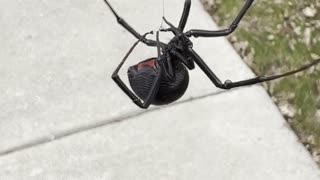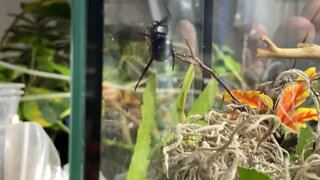Black Widow Spider Meets Murder Hornet (Asian Giant Hornet Vespa Mandarinia)
Black Widow Spider Meets Murder Hornet (Asian Giant Hornet Vespa Mandarinia)
Don’t try this at home!
Black Widow Spider: https://en.wikipedia.org/wiki/Latrodectus
From Wiki: Latrodectus is a broadly distributed genus of spiders with several species that, together, are commonly known as true widows. This group is composed of those often loosely called black widow spiders, brown widow spiders, and similar spiders. However, such general "common names" are of limited use, as the diversity of species is much greater. A member of the family Theridiidae, this genus contains 32 species, which include several North American "black widows" (southern black widow Latrodectus mactans, western black widow Latrodectus hesperus, and northern black widow Latrodectus variolus).
These small spiders have an unusually potent venom containing the neurotoxin latrotoxin, which causes the condition latrodectism, both named after the genus. Female widow spiders have unusually large venom glands and their bite can be particularly harmful to large vertebrates, including humans. Only the bites of the females are dangerous to humans. Despite their notoriety, Latrodectus bites rarely cause death or produce serious complications.
Due to the presence of latrotoxin in their venom, black widow bites are potentially dangerous and may result in systemic effects (latrodectism) including severe muscle pain, abdominal cramps, hyperhidrosis, tachycardia, and muscle spasms. Symptoms usually last for 3–7 days, but may persist for several weeks.
https://en.wikipedia.org/wiki/Asian_giant_hornet
From Wiki: The Asian giant hornet (Vespa mandarinia), including the color form referred to as the Japanese giant hornet, is the world's largest hornet. It is native to temperate and tropical East Asia, South Asia, Mainland Southeast Asia, and parts of the Russian Far East. It was also found in the Pacific Northwest of North America in late 2019 with a few more additional sightings in 2020, and nests found in 2021, prompting concern that it could become an invasive species.
-
 0:33
0:33
ViralHog
2 years ago $0.02 earnedBig Black Widow Spider Dangles From Web
3012 -
 0:41
0:41
imwithit
2 years agoFinding a Black Widow spider in a vacant house
36 -
 1:02
1:02
UnkleGrampas_Emporium
2 years ago $0.01 earnedFemale Black Widow
39 -
 2:02
2:02
Hall Homestead
2 years agofamily reacts to finding black widow spider
39 -
 1:00:59
1:00:59
Squaring The Circle w/ Randall Carlson
1 day ago#007 The Real Climate Crisis Noone Is Talking About and Mount Tambora Pt 2
59.8K14 -
 13:52
13:52
America Uncovered
1 day agoEveryone is WRONG About Trump's Guilty Verdict
37.4K81 -
 13:10
13:10
Censored TV
1 day agoThe Owen Benjamin vs Jim Goad debate was WILD
46.3K32 -
 25:27
25:27
Degenerate Plays
18 hours agoThe Microtransaction Master - Call Of Duty Modern Warfare Remastered : Part 3
50.1K2 -
 21:03
21:03
MYLUNCHBREAK CHANNEL PAGE
21 hours agoOld World Minnesota?
57K29 -
 5:49:05
5:49:05
Akademiks
1 day agoDrake Next Move - Whats next?? Did Lil Baby Listen to Me? Diddy and Family Preparing for Indictment?
115K54